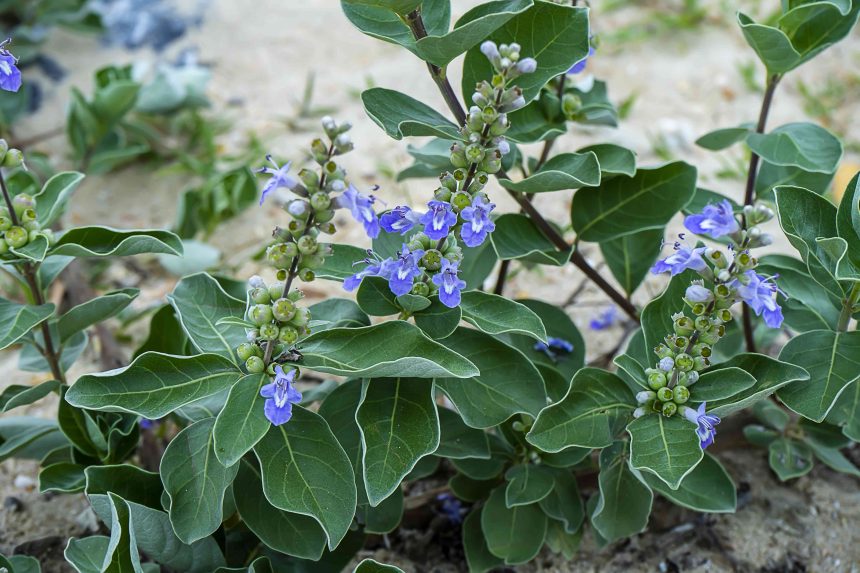Rapid growth, usually a desirable characteristic of groundcover plants, can backfire. Some popular groundcovers are so aggressive that they choke out any other plants in their path. Attempts to remove them are tedious at best and impossible at worst; some groundcovers are nearly impossible to eradicate. Here is a list of 12 of the worst offenders that you should never plant in your yard.
Groundcover plants are classified as invasive on a local, state, or federal level because they not only take over home landscapes but also escape into natural lands, outcompeting native plants and altering the ecosystem.
Beach Vitex
Noppharat05081977 / Getty Images
Initially introduced to North America from Korea, beach vitex (Vitex rotundifolia) was intended to help protect beaches from erosion, but this aggressive plant quickly grew out of control. It is a low-growing woody shrub that tolerates harsh growing conditions often found on dunes. Beach vitex has small, round leaves and a smooth, leathery texture. It produces clusters of purple flowers in May.
Bishop’s Weed
Andre’ Baranowski
Also called goutweed, bishop’s weed (Aegopodium podagraria) forms a low, leafy mat of variegated green and white foliage. As a groundcover, its dense canopy is very good at preventing weeds, but it spreads too aggressively itself to be useful in any landscape. When it escapes into the wild, it is known to quickly displace native species and inhibit the establishment of conifers and other native trees.
Chameleon Plant
Dean Schoeppner
Chameleon plant (Houttuynia cordata) is a perennial groundcover from Southeast Asia. It has variegated, heart-shaped leaves on quickly spreading stems that stand 1 to 2 feet tall. It thrives in shade and moist soil but grows just about anywhere. Once established, it’s nearly impossible to remove. If the smallest root is left in the soil, it will quickly regrow.
Creeping Jenny
Bob Stefko
Native to Europe and Asia, creeping Jenny (Lysimachia nummularia) was introduced to North America as an ornamental groundcover and then escaped into native areas where it is now considered an ecological threat. Its slender stems branch out from the mother plant and form roots wherever the leaf nodes touch the soil. It grows out of bounds very quickly.
English Ivy
An evergreen vine that forms a thick blanket of foliage at ground level, English ivy (Hedera helix) will overtake nearby plants including trees. It scrambles up trees, engulfs branches, shading and slowly killing the plant. Its waxy leaves repel herbicides, and any piece of root will quickly resprout. If you like the look of English ivy, only grow it as a houseplant.
Ice Plant
guy-ozenne / Getty Images
Ice plant (Carpobrotus edulis) is not to be confused with the well-behaved hardy ice plant (Delosperma cooperi). This plant is hardy in temperate and tropical regions (Zones 8–11). has become exceptionally problematic in California where it is displacing native species. Birds carry ice plant seeds into natural areas; seeds quickly sprout and form dense mats of foliage.
Japanese Bloodgrass
Blaine Moats
The striking red foliage of Japanese bloodgrass (Imperata cylindrica) has lured thousands of gardeners into planting this noxious grassy groundcover. Considered one of the 10 worst weeds in the world and listed on USDA’s Noxious Weed List, Japanese bloodgrass is a real threat. Although the red cultivar ‘Rubra’ is not considered invasive, it often reverts to the highly invasive 4- to 5-foot-tall green form.
Ribbon Grass
Marty Baldwin
Like Japanese bloodgrass, ribbon grass (Phalaris arundinacea) grows out of control quickly. Often planted to prevent erosion and stabilize a slope, ribbongrass grows quickly, forming a tall groundcover that is almost impossible to get rid of due to its fine and dense root system.
Vinca
Also known as periwinkle, vinca (Vinca minor) has glossy, evergreen foliage and purple or white flowers in spring. It has a bad reputation for escaping home landscapes and taking root in natural areas where it chokes out wildflowers and other natives. While it appears to be well-behaved in home landscapes, avoid any risks and don’t plant it.
Wintercreeper
A tenacious evergreen vine that grows in both poor or good soil and sun or shade, wintercreeper (Euonymus fortunei) masquerades as a garden problem solver, but don’t be fooled by this problem plant. In short order, it forms a dense mat of foliage at ground level, destroying every plant in its wake. It also climbs trees with abandon. It is nearly impossible to eradicate.
Yellow Archangel
Marty Baldwin
A member of the mint family, yellow archangel (Lamium galeobdolon) spreads quickly. It grows about 2 feet tall with yellow flower spikes in early summer. Stems root wherever they touch the ground, making it an aggressive, weedy plant that chokes out native species. It is particularly destructive in the Pacific Northwest.
Japanese pachysandra
Japanese pachysandra (Pachysandra terminalis) grows in shade and dry, crumbly soil, providing lush cover where other plants refuse to grow. This perennial is such a tenacious plant that it ranges far beyond the initial planting bed, destroying the ecosystem in its wake. Clump forming native sedge grasses (Carex spp.) are easy-care, drought-tolerant replacements for invasive Japanese pachysandra.
Non-Invasive Groundcover Plant Alternatives
From low-growing perennials to short shrubs, there are plenty of densely growing groundcovers you can plant instead. These stellar garden citizens prevent weeds, cool the root zones of nearby plants, and protect the soil from wind and water erosion, yet without being too aggressive or invasive. These include wintergreen, golden star (Chrysogonum virginianum), and barren strawberry.







